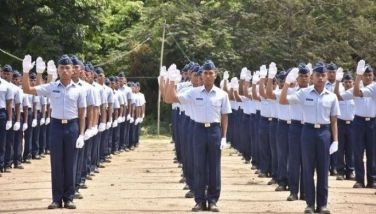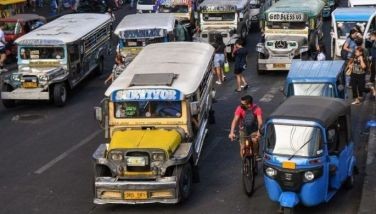What we know so far on the granular lockdown system in Metro Manila
MANILA, Philippines (Updated 6:57 p.m.) — With Metro Manila now under the loosest quarantine status once again, the capital region is set for the pilot run of the task force-approved granular lockdown system.
The idea is nothing new. Large-scale quarantine restrictions over entire regions have been the norm for the national government and the IATF since the coronavirus-induced community quarantines began, with granular lockdowns being a lower-level initiative offloaded to local governments.
These lockdowns covering smaller areas have actually long been implemented on the local government level. Quezon City, for example, has been declaring areas under Special Concern Lockdown as early as May 2020. Muntinlupa and Caloocan also just recently placed more areas under lockdown.
But how different is the national implementation? How will they even work? Is the National Capital Region ready? Here's what we know so far about the granular lockdown system approved by the Inter-Agency Task Force on Emerging Infectious Diseases.
What are granular lockdowns?
A granular or “micro lockdown” typically covers just a few streets or certain barangays of a given city, as determined by LGU officials. It can last from one week to several weeks, depending on the number of infections there.
Under the setup, no one is permitted to leave homes unless it’s to buy food and other essential goods, or for medical emergencies.
Speaking to reporters Monday, Metro Manila Development Authority chair Benhur Abalos emphasized the flexibility that the granular lockdown system could afford a damaged Philippine economy.
"This is more flexible. Where there is an infection, there will be a lockdown. We need a flexible policy, in the sense that while you contain the virus, the others can work," he is quoted as saying in Filipino by ABS-CBN News.
How does it work?
Operating capacities in areas under granular lockdown will be determined by the Department of Health depending on a number of health factors, including case count, hospital bed occupancy rate, and the presence of the Delta coronavirus variant.
- Alert Level 1: All industries open
- Alert Level 2: 50% capacity
- Alert Level 3: 30% capacity
- Alert Level 4: Closed
"The TWG did an alert level status because during lockdowns, three sectors are affected. So the alert levels are done to address the problems of these sectors. This will be like a typhoon," Abalos said in a separate interview over radio dzBB.
"We will still fine-tune it. We still have questions about that."
What has actually changed?
Though local governments have long been implementing the system on their own volition and under different names, the principle has remained largely the same across cities.
Speaking at a Palace briefing earlier Monday afternoon, though, presidential spokesperson Harry Roque disclosed one crucial difference this time around: if you go out of an area under granular lockdown, you can't go back in.
"One innovation is if you are an [Authorized Person Outside Residence], you can leave [your home] but you can no longer go back until the granular lockdown finishes. There's really no in-and-out," he said, adding that the constant "fine-tuning of the concept itself" will be another difference.
He also said that granular lockdowns need not be imposed on an entire barangay. "It can be a street, a house, a community."
Another difference, he said, is the "shared responsibility of giving aid" as social and health measures are set to be implemented by both the local and national governments.
For instance, the Muntinlupa City Health Office over the weekend said it was set to conduct a mass swab testing in the affected areas while local police is set to enforce total lockdown measures.
The City Social Service Department and barangay will also provide food packs and other basic items for residents affected by the lockdown.
The Muntinlupa health office also said that areas placed on lockdown are those that "have a very narrow case doubling time of two days, or the number of days for COVID-19 cases to double in number."
Pasay City Mayor Emi Calixto-Rubiano also said Thursday that all households placed under granular lockdowns are "provided with all their necessary needs especially food consisting not only canned goods but fresh produce as well like vegetables, meat and fruits."
She added that localized lockdowns do not mean that entire barangays have been closed, but only specific and targeted households or streets where there are a noticeably high number of cases.
Asked if the pilot run indicates that the newly-announced GCQ status will last for over two weeks, Roque had this to say: "Let's just say we're on pilot yet. We'll see if there's a better effect from these stricter localized lockdowns... If it proves to be more successful, we'll implement it."
When are they rolling out?
The Palace said Sunday that recommendations by the coronavirus task force on "new quarantine responses" are still up for President Rodrigo Duterte's approval.
To recall, the Inter-Agency Task Force on Emerging Infectious Diseases recommends policy, but the president may still overrule their suggestions as he did in January, when he overturned the task force's decision to allow minors back into shopping malls.
Duterte has generally approved the IATF's recommendations.
The National Capital Region is under modified enhanced community quarantine until September 7. The Palace said that general community quarantine restrictions would begin starting September 8 until the end of the month.
Interior Secretary Eduardo Año earlier said that the pilot testing for the granular lockdown in Metro Manila would begin September 8.
After that, it will be assessed, and a recommendation will then be delivered to Duterte.
Is Metro Manila ready for the new system?
San Juan City Mayor Francis Zamora told CNN Philippines' New Day that he felt it could be an effective system if mayors were to strictly implement it, adding that some chief executives have already been doing it for a while.
"Most of Metro Manila LGUs also do this," he said. "What you really need is to be very meticulous and very detailed in implementing it... It is a pilot. It will be tested in NCR from September 8 until the end of the month. We will see how effective it will be after a three-week implementation."
The Philippine National Police said in a statement Monday that it is ready to implement granular lockdowns should Duterte make the decision.
Based on data from the Philippine National Police, there are 51 barangays in Metro Manila that are currently under granular lockdown.
“The implementation of granular lockdown is a solution that our government sees to balance the opening up of the economy and the control of the spread of COVID-19. Your PNP supports this,” Police Gen. Guillermo Eleazar said.
“I urge the public to cooperate with measures and regulations that the government is imposing to stop the surge in COVID-19 cases. If not for ourselves, we will follow public health safety and quarantine protocols for the safety and health of our loved ones."
It is still unclear what the main difference between the national government's idea of granular lockdowns, and the ongoing localized lockdowns implemented by local government units.
With no national guidelines to go on, the capital region's chief executives still have not yet issued executive orders for their localities.
"We’re still waiting for the definition of granular lockdown, that's why there is still no executive order from Mayor [Francisco "Isko Moreno" Domagoso.] The executive order is needed since that will reiterate the national guidelines," Manila City public information officer Julius Leonen told reporters in a Viber message.
"As advised by our City Legal Officer, Atty. Jun Moreno, we’ll wait for national guidelines."
What have experts said?
Trade and Industry Secretary Ramon Lopez has said the granular lockdown will be better for the economy as it will allow more establishments and businesses to operate amid the threat of the COVID-19 pandemic.
But in an interview aired over ABS-CBN News Channel, OCTA Research fellow Guido David warned that the proposal might affect the country's control over the pandemic after weeks of enhanced community quarantine.
"We’re concerned that if this does not work, at a point when we’re actually seeing that the curve might plateau soon in two to three weeks, there’s a chance that we might lose effective control of the pandemic and it will become much worse than it is," he said, adding that no evidence exists that granular lockdowns can work outside of the existing small-scale setups.
"We’re not saying it will happen but we’re saying that — you know, based on history — there’s a significant chance that it may happen."
Health reform advocate Tony Leachon, a medical doctor, also told CNN Philippines that the shift back to the lighter GCQ coupled with the possible granular lockdowns were a "perfect storm" that could worsen COVID-19 cases.
"It would be a disaster if they will actually do MECQ to GCQ (general community quarantine) on a granular lockdown," he said.
"It's quite dangerous considering we have high positivity rate, we have high mobility, we have high reproduction number, we have low testings in a Delta variant environment with a demoralized workforce crisis," he also said.
Doubts over the efficacy of the idea on a larger scale also remain.
"Granular lockdowns would work if it’s concentrated in certain regions. For example, if you have only 40% of your barangays with new cases, then it’s feasible that you can impose the granular lockdowns and it may be effective," David said.
"Now, if they’re going to do granular lockdowns on a lot of barangays anyway, it will be manpower-intensive because they need people to guard, to man the stations, to bring food to these people who are under lockdown."
To date, health authorities have recorded 2.08 million coronavirus infections in the country, 157,646 of whom are still classified as active cases.
It has been 537 days since the first enhanced community quarantine was hoisted in some parts of Luzon to curb the spread of the coronavirus.
- Latest
- Trending


































